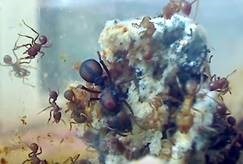A new study has discovered that leaf-cutter ant nests produce thousands of times more carbon dioxide than the adjacent soils do. In Costa Rica on the forest floor, leaf-cutter ant nests, that cover 1.2 per cent of the forest floor, make massive piles of dirt spotted with several holes that release carbon dioxide from the ant nests into the air, as much as 100,000 times more then surrounding soil. It is estimated that this contributes near 1 per cent of total forest carbon dioxide discharges, which in part adds to global warming. In the ants nest, fresh leaves are feed to fungi, which change the plant solid to a form that the ants can digest. The ant and fungal actions are what produce this carbon dioxide that escapes the soil through carbon dioxide chimneys. These ants move a lot of plant material that creates soil disturbance which is part of the carbon recycling.
Go Green Pest Control owner Randy Bilesky is a long-time South Delta resident. Trained and certified, Bilesky has first-hand knowledge of the pest problems that local homeowners and business owners encounter.


